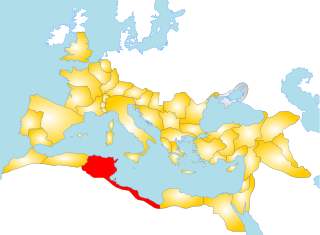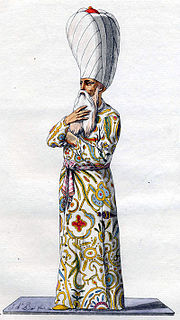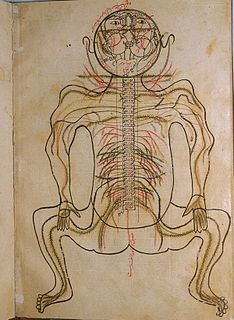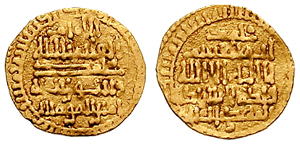Related Research Articles

The Fatimid Caliphate was an Ismaili Shia caliphate that spanned a large area of North Africa, from the Red Sea in the east to the Atlantic Ocean in the west. The dynasty of Arab origin ruled across the Mediterranean coast of Africa and ultimately made Egypt the center of the caliphate. At its height the caliphate included in addition to Egypt varying areas of the Maghreb, Sudan, Sicily, the Levant, and Hijaz.

Ifriqiya, known professionally as el-Maghrib el-Adna, was the area during medieval history comprising what is today Tunisia, Tripolitania and the Constantinois — all part of what was previously included in the Africa Province of the Roman Empire.

Abū Nuwās al-Ḥasan ibn Hānī al-Ḥakamī – variant: Al-Ḥasan ibn Hānī 'Abd al-Awal al-Ṣabāḥ, Abū 'Alī, known as Abū Nuwās al-Salamī or just Abū Nuwās –, was a classical Arabic poet. Born in the city of Ahvaz, in modern-day Iran, to an Arab father and a Persian mother, he became a master of all the contemporary genres of Arabic poetry. He also entered the folkloric tradition, appearing several times in One Thousand and One Nights. He died during the Great Abbasid Civil War before al-Ma’mūn advanced from Khurāsān in either 199 or 200 AH.

Sultan of Egypt was the status held by the rulers of Egypt after the establishment of the Ayyubid dynasty of Saladin in 1174 until the Ottoman conquest of Egypt in 1517. Though the extent of the Egyptian Sultanate ebbed and flowed, it generally included Sham and Hejaz, with the consequence that the Ayyubid and later Mamluk sultans were also regarded as the Sultans of Syria. From 1914, the title was once again used by the heads of the Muhammad Ali dynasty of Egypt and Sudan, later being replaced by the title of King of Egypt and Sudan in 1922.

Saif ad-Din Qutuz, also romanized as Kutuz, Kotuz, and fully al-Malik al-Muzaffar Saif ad-Din Qutuz, was the third or fourth of the Mamluk Sultans of Egypt in the Turkic line. He reigned for less than a year, from 1259 until his assassination in 1260.

Manṣūr ibn Muḥammad ibn Aḥmad ibn Yūsuf Ibn Ilyās was a late 14th century and early 15th century Persian physician from Shiraz, Timurid Persia, commonly known for his publication of the colored atlas of the human body, Mansur’s Anatomy. It is important to know that al-Jurjani (1040–1136) published a book called "Zakhireye Khwarazmshahi" which Mansur could have copied the illustrations from his book.
Jawhar ibn Abdallah was a Fatimid general who led the conquest of Maghreb, and subsequenly the conquest of Egypt, for the 4th Fatimid Imam-Caliph al-Mu'izz li-Din Allah. He served as viceroy of Egypt until al-Mu'izz's arrival in 973, consolidating Fatimid control over the country and laying the foundations for the city of Cairo. After that, he retired from public life until his death.

Abu'l-Qasim Muhammad ibn Abdallah, better known by his regnal name al-Qa'im bi-Amr Allah or bi-Amri 'llah, was the second caliph of the Fatimid Caliphate in Ifriqiya and ruled from 934 to 946. He is the 12th Imam according to the Isma'ili faith.
Aḥmad ibn Abī Ya‘qūb ibn Ja'far ibn Wahb ibn Waḍīḥ al-Ya‘qūbī, known as Ahmad al-Ya'qubi, or Ya'qubi, was a Muslim geographer and perhaps the first historian of world culture in the Abbasid Caliphate.
Pope Athanasius III of Alexandria, 76th Pope of Alexandria and Patriarch of the See of St. Mark.
Baghdadi or Al-Baghdadi may refer to:
The History of the Patriarchs of Alexandria is a major historical work of the Coptic Orthodox Church of Alexandria. It is written in Arabic, but draws extensively on Greek and Coptic sources.

Abu Ali Salih ibn Mirdas, also known by his laqabAsad al-Dawla, was the founder of the Mirdasid dynasty and emir of Aleppo from 1025 until his death in May 1029. At its peak, his emirate (principality) encompassed much of the western Jazira, northern Syria and several central Syrian towns. With occasional interruption, Salih's descendants ruled Aleppo for the next five decades.
Ahmad ibn al-Qadi or Ibn al-Qadi,(December 18, 1552 – December 6, 1616), fully Shihab al-Din abu l-‘Abbas Ahmad ibn Mohammed ibn Mohammed ibn Ahmed ibn Ali ibn 'Abd er-Rahman ibn Abi'l-' Afiyya el-Miknasi ez-Zanati, was the leading writer from Ahmad al-Mansur's court in Morocco next to Abd al-Aziz al-Fishtali. He was also a renowned judge and mathematician.

Al-Ashraf Zayn ad-Din Abu al-Ma'ali Sha'ban ibn Husayn ibn Muhammad ibn Qalawun, better known as al-Ashraf Sha'ban or Sha'ban II, was a Mamluk sultan of the Bahri dynasty in 1363–1377. He was a grandson of Sultan an-Nasir Muhammad. He had two sons who succeeded him: al-Mansur Ali and as-Salih Hajji.
The Kaysanites were a Shi'i sect of Islam that reportedly formed from the followers of Al-Mukhtar. They are often described in later literature as ghulat – a kind of heretic.
Al Malik Al-Mujahid Asad ad-Din Shirkuh II was the Ayyubid emir of Homs from 1186–1240. He was the son of An-Nasir Muhammad ibn Shirkuh, grandson of Shirkuh and second cousin of Saladin. His domains also included Palmyra and ar-Rahba. Al Mujahid became emir at the age of thirteen when his father died unexpectedly in Homs on 4 March 1186.

Banu Kilab was an Arab tribe that dominated central Arabia during the late pre-Islamic era. It was a major branch of the Banu 'Amir ibn Sa'sa' tribe and was thus of Qaysi lineage. During and after the Muslim conquest of Syria, Kilabi tribesmen migrated to northern Syria. Their chieftain Zufar ibn al-Harith al-Kilabi led the Qaysi revolt against the Umayyad Caliphate until he secured peace with the latter in 691.
Asad al-Dīn Jughrīl ibn ‘Abd Allāh al-Kāmilī was the Ayyubid Emir of Mecca from 1235 to 1238.
References
- ↑ "Mansur al-Kamili - Google Search". www.google.ca. Retrieved 2017-10-25.
| This article about an Egyptian scientist is a stub. You can help Wikipedia by expanding it. |